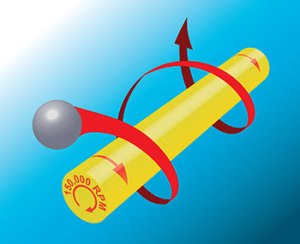Vibrate a solution of rod-shaped metal nanoparticles in water with ultrasound and they'll spin around their long axes like tiny drill bits. Why? No one yet knows exactly. But researchers at the National Institute of Standards and Technology (NIST) have clocked their speed—and it's fast. At up to 150,000 revolutions per minute, these nanomotors rotate 10 times faster than any nanoscale object submerged in liquid ever reported.
 Inference of nanorod rotation: A nanoparticle traces the microvortical flow around a nanorod rotating at up to 150,000 RPM propelled by ultrasound. Credit: Balk/NIST
Inference of nanorod rotation: A nanoparticle traces the microvortical flow around a nanorod rotating at up to 150,000 RPM propelled by ultrasound. Credit: Balk/NIST
The discovery of this dizzying rate has opened up the possibility that they could be used not only for moving around inside the body—the impetus for the research—but also for high-speed machining and mixing.
Scientists have been studying how to make nanomotors move around in liquids for the past several years. A group at Penn State looking for a biologically friendly way to propel nanomotors first observed that metal nanorods were moving and rotating in response to ultrasound in 2012. Another group at the University of California San Diego then directed the metal rods' forward motion using a magnetic field. The Penn State group then demonstrated that these nanomotors could be propelled inside of a cancer cell.
But no one knew why or how fast the nanomotors were spinning. The latter being a measurement problem, researchers at NIST worked with the Penn State group to solve it.
"If nanomotors are to be used in a biological environment, then it is important to understand how they interact with the liquid and objects around them," says NIST project leader Samuel Stavis. "We used nanoparticles to trace the flow of water around the nanomotors, and we used that measurement to infer their rate of rotation. We found that the nanomotors were spinning surprisingly rapidly."
The NIST team clocked the nanomotors' rotation by mixing the 2-micrometer-long, 300-nanometer-wide gold rods with 400-nanometer-diameter polystyrene beads in water and putting them between glass and silicon plates with a speaker-type shaker beneath. They then vibrated the shaker at an ultrasonic tone of 3 megahertz—much too high for you or your dog to hear—and watched the motors and beads move.
As the motors rotate in water, they create a vortex around them. Beads that get close get swept up by the vortex and swirl around the rods. By measuring how far the beads are from the rods and how fast they move, the group was able to work out how quickly the motors were spinning—with an important caveat.
"The size of the nanorods is important in our measurements" says NIST physicist Andrew Balk. "We found that even small variations in the rod's dimensions cause large measurement uncertainties, so they need to be fabricated as uniformly as possible for future studies and applications."
According to the researchers, the speed of the nanomotors' rotation seems to be independent of their forward motion. Being able to control the "speed and feed" of the nanomotors independently would open up the possibility that they could be used as rotary tools for machining and mixing.
Future avenues of research include trying to discover exactly why the motors rotate and how the vortex around the rods affects their interactions with each other.
*A.L. Balk, L.O. Mair, P.P. Mathai, P.N. Patrone, W.Wang, S. Ahmed, T.E. Mallouk, J.A. Liddle and S.M. Stavis. Kilohertz rotation of nanorods propelled by ultrasound, traced by microvortex advection of nanoparticles. ACS Nano, Articles ASAP (As Soon As Publishable) Publication Date (Web): July 14, 2014. DOI: 10.1021/nn502753x.